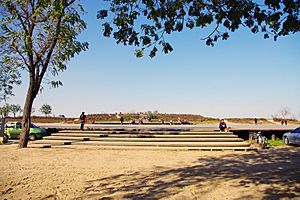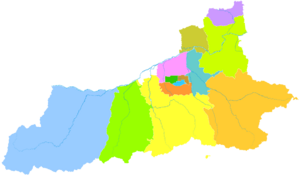Weiyang District, Xi'an facts for kids
Quick facts for kids
Weiyang
未央区
|
|||||||||||||||||||||||||||||||||||
|---|---|---|---|---|---|---|---|---|---|---|---|---|---|---|---|---|---|---|---|---|---|---|---|---|---|---|---|---|---|---|---|---|---|---|---|
|
District
|
|||||||||||||||||||||||||||||||||||

Ruins of Weiyang Palace
|
|||||||||||||||||||||||||||||||||||
| Country | People's Republic of China | ||||||||||||||||||||||||||||||||||
| Province | Shaanxi | ||||||||||||||||||||||||||||||||||
| Sub-provincial city | Xi'an | ||||||||||||||||||||||||||||||||||
| Area | |||||||||||||||||||||||||||||||||||
| • Total | 264.41 km2 (102.09 sq mi) | ||||||||||||||||||||||||||||||||||
| Population
(2020)
|
|||||||||||||||||||||||||||||||||||
| • Total | 733,403 | ||||||||||||||||||||||||||||||||||
| • Density | 2,773.73/km2 (7,183.94/sq mi) | ||||||||||||||||||||||||||||||||||
| Time zone | UTC+8 (China Standard) | ||||||||||||||||||||||||||||||||||
| Postal code |
710016
|
||||||||||||||||||||||||||||||||||
| Xi'an district map |
|
||||||||||||||||||||||||||||||||||
Weiyang District (simplified Chinese: 未央区; traditional Chinese: 未央區; pinyin: Wèiyāng Qū) is one of 11 urban districts in Xi'an, the capital city of Shaanxi Province in China. It is located in the northwest part of Xi'an. Weiyang District is the city's new main administrative area.
This district is very important historically. Its name comes from the ancient Weiyang Palace, which means "prosperity never ends." Weiyang District is also known as the starting point of the famous Silk Road. Over 11 ancient dynasties built their capital cities here. Some of the most important historical sites, like the ruins of Epang Palace, Daming Palace, and Han Chang'an City, are protected national treasures.
Contents
Understanding Weiyang District
Where is Weiyang District?
Weiyang District is in northwest Xi'an. It shares borders with Baqiao District to the east and the city of Xianyang to the west. To the north, it borders Xincheng District and Lianhu District. To the southwest, it is next to Yanta District and Changan District. The total area of the district is about 264.41 square kilometers (about 102 square miles). In 2020, over 733,403 people lived here.
How is Weiyang District Managed?
As of 2021, Weiyang District is divided into 11 smaller areas called subdistricts. These subdistricts help manage the different parts of the district.
|
|
Nature and Weather
What is the Climate Like?
Weiyang District has a climate similar to a humid continental climate. This means it has four clear seasons. The amount of rain each year is moderate.
Seasons in Weiyang
- Spring: From March to May, temperatures rise quickly. They usually go from about 8°C (46°F) to 19°C (67°F). About a quarter of the yearly rain falls during spring.
- Summer: This season is hot with lots of rain. Average temperatures are around 25-27°C (76.6-80.6°F). On about 22 days each year, the temperature reaches 35°C (95°F) or higher. Sometimes, it can even get hotter than 40°C (104°F). Summer brings about 37% of the total yearly rainfall.
- Autumn: After summer, temperatures drop fast. From September to November, the average temperature goes from about 19.6°C (67.3°F) down to 6.8°C (44.2°F). About 19% of the yearly rain falls in autumn. This season usually has the calmest winds.
- Winter: Winter is cold with very little rain or snow. In January, the average temperature is around -0.5°C (31°F). The coldest temperatures can drop below -10°C (14°F). Winter is dry, with only about 4% of the yearly rain or snow.
Wind Patterns
Most winds in Weiyang District come from the northeast. The next most common winds are from the southwest. The average wind speed is about 2 meters per second (6.56 feet per second).
Water Systems
Weiyang District has the largest water system in Xi'an. All its rivers are branches of the famous Yellow River. The Wei River flows through the north, the Ba River and Chan River flow through the east, and the Zao River flows through the west.
Places to Visit
Historical Sites
Epang Palace Ruins
The site of Epang Palace is what's left of a huge palace from the Qin dynasty. This was China's first strong, unified empire. The Epang Palace was one of "Qin Shi Huang's Four Major Projects," along with the Great Wall and the Terracotta Army. Building started in 212 B.C., but the palace was never finished because the Qin dynasty fell in 206 B.C. The ruins are huge, covering an area of 544,000 square meters (134.4 acres). In 1992, UNESCO recognized it as one of the world's most important palace sites.
Daming Palace Ruins
The site of Daming Palace is mostly in Weiyang District. It was once the largest palace in Chang'an, the capital city of the Tang dynasty. This palace was enormous, with walls thousands of feet long. It was also listed as a national cultural relic in 1961. In 2010, the ruins were turned into a National Heritage Park. In 2014, the Daming Palace site became a World Heritage Site.
Han Chang'an City Site
The site of Han dynasty's capital, Chang'an, is one of the biggest and best-preserved ancient capital sites in China. The city walls were built between 194 B.C. and 190 B.C. The entire site covers about 75 square kilometers (18,533 acres). It was recognized as a national cultural relic in 1961.
Weiyang Palace Site
The site of Weiyang Palace was built around 200 B.C. It had over 40 halls and served as the main government center for 11 later dynasties for more than 360 years. This makes it the longest-used palace in ancient Chinese history. The ruins today are about 350 meters (1,148 feet) long and 150 meters (492 feet) wide. It was also listed as a national cultural relic in 1961 and became a World Heritage Site in 2014.
Museums to Explore
Han Chang'an City Relics Exhibition Museum
This museum is the first one dedicated to showing everything about the ancient Han Chang'an City. It opened in 2009 and was updated in 2013. It has two main exhibition halls. One hall tells the story of Chang'an City, its layout, culture, and what archaeologists have found. The second hall focuses on the Silk Road, since Chang'an was its starting point.
Other Museums
- Xi'an Meidu Museum: This museum shows off beautiful Chinese porcelain and enamel items from the Ming and Qing dynasties.
- Yu Youren Calligraphy Art Museum: Here, you can see amazing calligraphy artworks by the artist Yu Youren.
- Xi'an Royal Art Museum: This large museum displays art treasures that once belonged to royal families from different dynasties.
- Xi'an Jingwen Ox Culture Ceramics Museum: This is the only museum in China dedicated to oxen! It has many ox-related ceramic artworks from the 13 dynasties that had their capitals in Xi'an.
- Snowflake Beer Museum: Learn about the history of beer in China, how it's made, and how to enjoy it.
- Xi'an Yaguan Porcelain Art Museum: This museum focuses on modern porcelain art.
Parks and Scenic Spots
- Han City Lake National Water Conservancy Scenic Area
- Wiyang Lake Amusement Park
- Xi'an City Athletic Park
- Chan-Ba National Wetland Park
- Xi'an Wei River Ecological Landscape Scenic Area
Getting Around Weiyang
Major Roads
Weiyang District has several important expressways, which are like big highways. These include:
- Xibao Expressway
- Xitong Expressway
- Xiyan Expressway
- Xitong Expressway
- Xi'an City Ring Expressway
- Airport Expressway Line 1
- Airport Expressway Line 2
Metro Lines
The Xi'an Metro has several lines that run through Weiyang District, making it easy to travel around the city:
- Xi'an Metro Line 1
- Xi'an Metro Line 2
- Xi'an Metro Line 3
- Xi'an Metro Line 4
Airport Access
Xi'an Xianyang International Airport (XIY)
Weiyang District is only about 8 kilometers (5 miles) from Xi'an Xianyang International Airport. This airport is one of the biggest and busiest in Northwest China. It first opened in 1991. Over the years, new terminals have been added to make it even larger and more modern.
Train Travel
Xi'anbei Railway Station
The Xi'anbei Railway Station is located right in Weiyang District. It is one of the main train stations in Xi'an and the most important passenger station in Northwest China's railway system. It opened in 2011 and is very large, covering about 338,000 square meters (83.5 acres).
Images for kids
See also
 In Spanish: Weiyang para niños
In Spanish: Weiyang para niños



